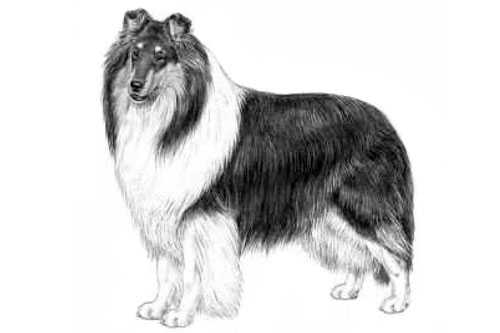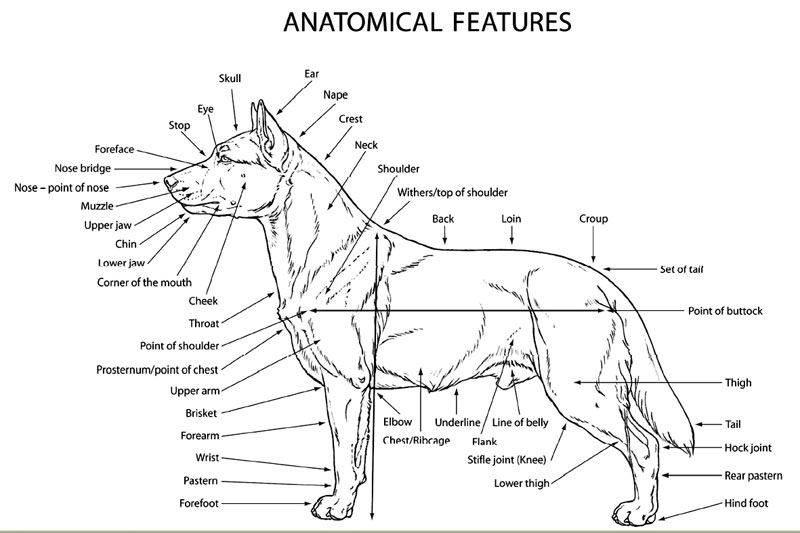This illustration does not necessarily show the ideal example of the breed
Origin: United Kingdom
Date of publication of the official valid Standard: 08.10.2012
Utilization: Sheepdog
Classification F.C.I.: Group 1 Sheepdogs and Cattle Dogs.
Section 1, Sheepdogs Without working trial
Brief Historial Summary:
The rough and the smooth Collie is the same with the exception of coat length. The breed is thought to have evolved from dogs brought originally to Scotland by the Romans which then mated with native types.
Purists may point to subtle differences which have appeared as individual breeders selected stock for future breeding, but the fact remains that the two breeds derived very recently from the same stock and, in truth, share lines which can be
found in common to this day. The Rough Collie is the somewhat refined version of the original working collie of the Scottish shepherd, from which it has been selected over at least a hundred years. Many of the dogs can still perform
satisfactorily at work, offered the chance. The basic message is that for all his beauty, the Collie is a worker.
General appearance:
Appears as a dog of great beauty, standing with impassive dignity, with no part out of proportion to whole. Physical structure on lines of strength and activity, free from cloddiness and with no trace of
coarseness. Expression most important. In considering relative values it is obtained by perfect balance and combination of skull and foreface, size, shape, colour and placement of eyes, correct position and carriage of ears.
Behavior / Temperament:
Friendly disposition with no trace of nervousness or aggressiveness. A great companion dog, friendly, happy and active, good with children and other dogs.
Head:
Head properties of great importance must be considered in proportion to size of dog. Viewed from front or side, head resembles a well-blunted clean wedge, being smooth in outline. Sides taper gradually and
smoothly from ears to end of black nose. Viewed in profile, top of skull and top of muzzle lie in two parallel straight lines of equal length divided by the stop. A mid-point between inside corner of eyes (which is centre of a correctly placed
stop) is centre of balance in length of head. Depth of skull from brow to underpart of jaw never excessive (deep through).
Cranial region:
Skull: Flat.
Stop: Slight, but perceptible.
Facial region:
Nose: Always black. Muzzle: End of smooth, well rounded muzzle blunt, never square. Not pinched.
Jaws / Teeth: Jaws strong, under-jaw clean cut. Teeth of good size.
A perfect, regular and complete scissor bite, i.e. upper teeth closely overlapping lower teeth and set square to the jaws.
Cheeks: Cheekbones not prominent.
Eyes: Very important feature giving sweet expression. Medium size (never very small) set somewhat obliquely, of almond-shape and dark brown colour, except in the case of blue merles when eyes are frequently (one or both, or part of one
or both) blue or blue-flecked. Expression full of intelligence, with quick, alert look when listening.
Ears: Small, not too close together on top of skull, nor too far apart. In repose carried thrown back, but on alert brought forward and carried semi-erect, that is, with approximately two-thirds of ear standing erect, top third
tipping forward naturally, below horizontal.
Neck:
Muscular, powerful, of fair length, well arched.
Body:
Slightly long compared with height.
Back: Firm.
Loin: Slight rise.
Chest: Deep; fairly broad behind shoulders; ribs well sprung.
Tail:
Long with bone reaching at least to hock joint. Carried low when quiet but with slight upward swirl at tip. May be carried gaily when excited, but never over back.
Limbs:
Forequarters:
Shoulder: Sloping and well angulated.
Elbow: Neither turned in nor out.
Upper arm: Approximately equal in length with shoulder blade.
Forearm: Forelegs straight and muscular, with moderate amount of round bone.
Forefeet: Oval; soles well padded. Toes arched and close together.
Hindquarters:
Thigh: Muscular.
Stifle (Knee): Well bent.
Lower thigh: Clean and sinewy.
Hock joint: well let down and powerful.
Hind feet: Oval; soles well padded. Toes arched and close together. Slightly less arched than forefeet.
Gait / Movement:
Distinctly characteristic in this breed. A sound dog is never out at the elbow, yet moves with front feet comparatively close together. Plaiting, crossing or rolling is highly undesirable. Hind legs from hock
joint to ground when viewed from rear to be parallel but not too close; when viewed from side, action is smooth. Hind legs powerful with plenty of drive. A reasonably long stride is desirable and should be light and appear effortless. Absolute
soundness essential.
Coat:
Hair: Fits outline of body, very dense. Outer coat straight and harsh to touch, undercoat soft, furry and very close almost hiding the skin; mane and frill very abundant, mask and face smooth, ears smooth at tips, but
carrying more hair towards base, front legs well feathered, hind legs above hocks profusely feathered, but smooth below hock joint. Hair on tail very profuse
Colour: Sable, Tricolour and Blue Merle.
Sables: any shade of light gold to rich mahogany or shaded sable. Light straw or cream coloured highly undesirable.
Tricolour : predominantly black with rich tan markings about legs and head. A rusty tinge in top coat highly undesirable.
Blue Merle: predominantly clear, silvery blue, splashed and marbled with black. Rich tan markings preferred, but absence should not be penalised. Large black markings, slate colour, or rusty tinge either of top or undercoat are highly
undesirable.
All should carry typical white Collie markings to a greater or lesser degree. Following markings are favourable – white collar, full or part, white shirt, legs and feet, white tail tip. A blaze may be carried on muzzle or
skull, or both. All white or predominantly white is highly undesirable.
Size:
Height at the withers: Males: 56 – 61 cms. Females: 51 – 56 cms.
Faults:
Any departure from the foregoing points should be considered a fault and the seriousness with which the fault should be regarded should be in exact proportion to its degree and its effect upon the health and
welfare of the dog and on its ability to perform its traditional work.
Disqualifying faults:
Aggressive or overly shy.
Any dog clearly showing physical or behavioural abnormalities shall be disqualified.
N.B:
Male animals should have two apparently normal testicles fully descended into the scrotum.
Only functionally and clinically healthy dogs, with breed typical conformation, should be used for breeding.
The latest amendments are in bold characters.




